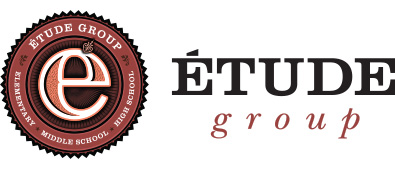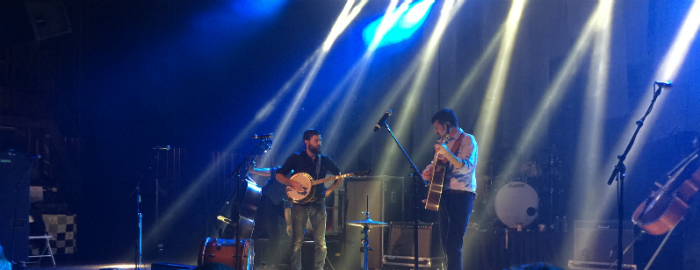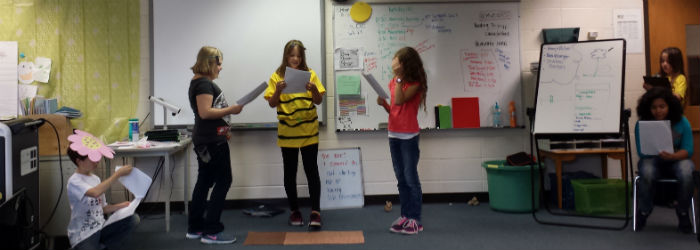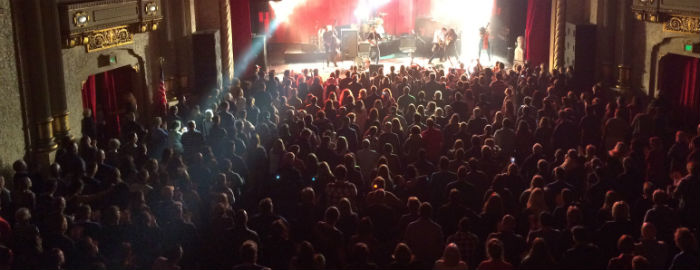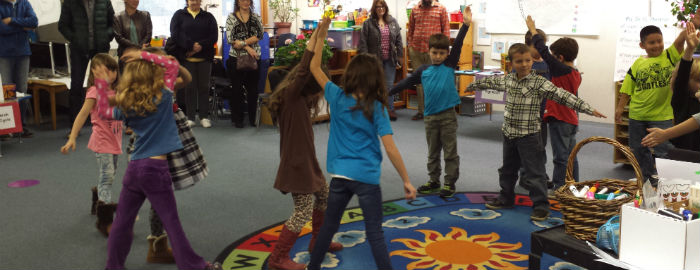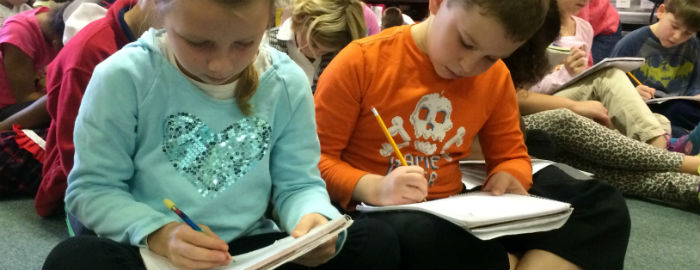by: Janelle Bane
Second and Third Graders Learn About Geography in the Field
The second and third grade classes visited Pigeon River, Kohler Andrae Park and The Kettle Moraines over the last three months to make observations and work together in the classroom to research Wisconsin landforms, practice reading and writing skills, and integrate movement into their research. Through trips to area landscapes, each classroom brought their knowledge and questions back to school as tools for learning and extending by thinking critically about what they’ve seen.
The Pigeon River lies just through the backyard of the school and offers a wonderful setting to explore and practice observing in nature. Students noticed such things as how the water flows, how the land slopes downward toward the river and the sizes of rocks along the path and recorded them in their field journals. Mrs. Pasche’s class found rapids on the river that offered a lot of new vocabulary, “we learned about the cut bank, the point bar, eddies, erosion, and deposition all at this one spot!” Back in the classroom, students worked on visualizing that experience and writing about it with descriptive words. In Mrs. Pekarek’s class, students worked in partners, giving feedback to help strengthen their writing by making it more descriptive of the things they noticed at the river.
The dunes and the marsh at Kohler Andrae gave the students a completely different perspective of the land. Field journals in hand, students stopped along the cording and recorded observations about the landscapes. Why is there sand in the grass? How did it get there? In two trips to the State Park, they visited the slow-moving waters of the marsh, sandy dunes, grassy prairie and the Lake Michigan shore. At the Marsh, students were asked to complete a See-Think-Wonder thinking routine. The wonders of Mrs. Faul’s class “included why the land looked so different from the sand dunes, and how they could be so close together. We wanted to know how the marsh was formed and where it began and ended. These wonders helped to fuel research later on in the week.”

The similarities and differences in the landscapes of both places left questions that needed answering for all three classrooms. “The students have been reading lots of texts and articles to figure out how all the beautiful places in Wisconsin were made. This is the research part of our project. We noticed that glaciers played a big part in forming the land and now we want to find out more about glaciers,” Mrs. Pekarek noted in her weekly blog. Mrs. Pasche’s class wrote descriptive essays about the landforms at Kohler Andrae park, using adjectives and vocabulary they researched after the trip and read more about rocks and minerals in small reading groups: “To further our studies of Wisconsin's landforms, processes that shape land, and rocks and minerals, students researched the properties of rocks and sorted them into the 3 types. Small reading group books are also giving students background knowledge about rocks and minerals and glaciers.”
A few weeks later, the on a brisk, windy day in November, the three classes would have their chance to observe more evidence of glaciers. They braved the chill of our first snow and trekked along the trail of the Parnell Tower in the Kettle Moraines where it joins with the Ice Age Trail, a trail that is famous for its glacial beginnings. They’d come across different evidence of glaciers at Kohler Andrae, so they had some prior knowledge of how glaciers shaped the land. In the Kettles, they can see how it looks completely different from the lake, the marsh, or the river.

At one stop, they completed a Looking 10x2 thinking routine by finding a spot to sit and recording ten observations in their field journal. After a few minutes, they repeated the exercise from a new vantage point. Another stop, at the edge of the Greenbush Kettle Hole, students were asked to make a claim about this landform and support it with evidence in their journals. Students claimed that a glacier formed the great hole, and looked around for evidence from their research. At the top of the tower, students had a bird’s-eye view of the region they’d been researching and observing all trimester.

The thinking routines allow students to combine what they already know, what they see and how that makes them wonder. In this way, students make the connections between what they are observing in real-life landscapes and the research they’ve been doing in class about erosion, glaciers and weathering. Their own observations and questions guide their learning in the classroom and gives deeper meaning to the research of rocks and minerals, reading fiction and nonfiction books about geography.

At their Exhibition of Learning, students had the opportunity to share this learning with their families through various media. Each class created a movement piece choreographed to their recording of the poem "Wisconsin Destiny." They first created tableaus of the poem in Drama class, then reworked their ideas into interpretive movements about the landforms of Wisconsin. Families circulated through small groups of students who presented in more detail their explorations of landforms, their classroom research, painted reflections and thinking routines. This trimester, these second and third graders have a whole new outlook and understanding of how the land around them was created. One student explained that this learning changed the way she sees the land around her: "I used to think that Lake Michigan was just there, but now I know that it was made from glaciers. I had never thought about how a lake was made before."
by: Tad Phippen Wente, College Readiness Coordinator
Juniors learn about advantages of Two-Year Colleges from UW-Sheboygan Rep
IDEAS Academy juniors learned about attending UW-Sheboygan Tuesday, Dec. 15, when Admissions Recruiter Milissa Kloida came to speak. She focused on the “big decisions” young people need to make about living, finances, and career.
by: Ted Hamm
Simply, Thank You
Dear Families, Students, Staff, Supporters, and Friends
by: Janelle Bane
A Trimester of Bee Research and Learning with the Fourth and Fifth Graders
In the first trimester of the year, the fourth and fifth graders of ESAA studied ecosystems. What better way to study ecosystems than through the lens of bees and their contribution to a healthy environment. To begin, each class performed a “Generate and Sort” thinking routine that helped to grasp knowledge students already had about bees and captured all the questions students have about our buzzing friends. This research continues throughout the trimester, learning more about bees to better understand why they are important to our ecosystem, and culminating in a final project to help support bees and their important work. 20150921 142310
by: Janelle Bane
Giving Tuesday: Fantastic Ways to Show Your Love for Étude
Tomorrow, December 1st, is a day that has become widely known as *Giving Tuesday*[http://www.givingtuesday.org/about/], a term coined by the 92nd Street Y in New York City in 2012. Falling in line after Black Friday, Small Business Saturday, and Cyber Monday, Giving Tuesday is a day dedicated to giving to charities and causes you care about. Now, you can include The Étude Group of Schools in your #GivingTuesday plans through the Étude Sessions.
by: Ted Hamm
Presentations of Learning: Thoughts as a Parent and Advisor
Dear Families,
by: Ted Hamm
Have A Playful Thanksgiving!
As we head into Thanksgiving weekend, I want to wish everyone a playful Thanksgiving and encourage everyone to take time for a little free play. Free play is cited has helping build resilient children in a recent article titled, "How Free Play Can Define Kids’ Success". The article points out that creative play can help our kids develop resiliency by developing:
by: Janelle Bane
With Amazon Smile, Your Purchases Help Build Community
Here at The Étude Group of Schools, IDEAS Academy, The Mosaic School, and Elementary School for Arts and Academics, we value not only the community within our walls, but what impact we make as individuals and as a group in our larger community. Through project-based learning, we can situate our academic learning into real-life, relevant issues in our community like monarch migration[/elementaryschool/esaa-blog/first-grade-exhibitions-of-learning-why-are-butterflies-important/], native species awareness[/middleschool/mosaic-blog/mosaic-at-maywood-native-animals-and-energy-transfers/], and high school health[/highschool/ideas-blog/ideas-human-anatomy-and-physiology-class-hold-health-fair-at-school/]. If this is something you value, we'd like you to consider supporting us in our mission[/about-us/educational-program/].
by: Janelle Bane
First Grade Exhibitions of Learning: Why are Butterflies Important?
The first grade students of ESAA have spent the trimester exploring the question, “Why are monarch butterflies important?” Butterfly habitats, conservation, and the environment in general is an extremely relevant topic at the moment and also provides many opportunities to incorporate science, literacy, movement, and music.
by: Janelle Bane
Parent Connections: Literacy at ESAA
*Tuesday, November 17th at 6:30 pm*
